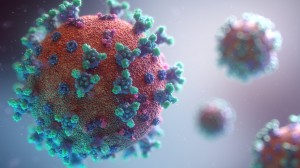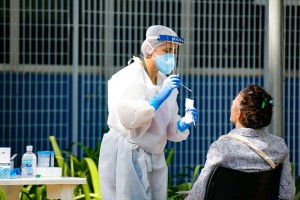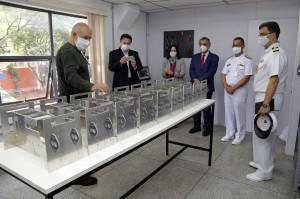USP’s COVID-19 response
(by Filipe Albessu Narciso) – May 18th, 2021
Over one year since the coronavirus outbreak was considered a pandemic by the World Health Organization (WHO), the international community has suffered from an atypically difficult year. More than a million lives have been claimed by the virus, leaving a sentiment of collective grief. However, frontline workers, researchers and scientists have done so much during the pandemic that society has witnessed groundbreaking changes, such as the fast development of various types of efficient vaccines. Among many research institutions, USP has also contributed directly to the academic community and overall society in these troubling times.

According to data gathered by the vice-president research office at USP, which can be accessed in Portuguese here, the university is responsible for more than 250 research projects on COVID-19. Among these, there are sustainable, economical and efficient devices for patients’ ventilation assistance, new infection identification methods and health analysis tools based on Big Data.
On February 26th, 2020, Brazil confirmed its first coronavirus infection. Two days later, a group of USP’s women scientists was enthusiastically praised for being able to sequence the SARS-COV-2 genome, while the worldwide average was about 15 days. Ester Sabino, former director of USP’s Tropical Medicine Institute, and Jaqueline Góes de Jesus, research coordinator, represented their Institute in a joint work with Adolfo Lutz Institute and Oxford University scientists through the Cadde project, an initiative by both the São Paulo Research Foundation and the UK’s Medical Research Center.
Ever since the genome sequencing, Sabino has been a protagonist in tracking the pandemic in Brazil and the world. Her influence has recently been recognized through a new prize established in her honour, called “Prêmio Ester Sabino para Mulheres Cientistas do Estado de São Paulo”, which stands for rewarding women scientists from the state of São Paulo for their admirable work. Góes was also present at her virtual ceremony.
In March 2020, the Biomedical Sciences Institute of USP started distributing inactivated viruses for laboratories throughout Brazil in order to enable them to make PCR COVID-19 tests and carry out new research. The project counted with an associated effort from the institute, the national mailing service and the Brazilian Ministry of Science, Technology and Innovation.

As the virus started to spread throughout the entire country, USP united with other 2 institutions, the São Paulo State University (Unesp) and the Federal University of ABC (UFABC), to gather trustworthy data that could explain the dynamics of COVID-19. Using data from the Brazilian Health Ministry and math tools, the so-called COVID-19 observatory generated charts analyzing the disease from many angles, such as the efficiency of social isolation and the speed with which the virus spreads.
Still in March, USP also started a project to distribute low-cost masks to hospital personnel. When the pandemic started, Brazil suffered from a shortage of face mask offers, even to health professionals, as a result of its high demand. The project, coordinated by professors from the Physics Institute as well as from the Polytechnic School, produced a million masks while using alternative technology and materials, and served as a source of income for professionals, sewing shops and the supply chain. The masks, which consisted of the N95/PFF2 type that is recommended to health workers, were distributed to hospitals linked to USP.
In April, the School of Architecture and Urbanism (FAU) developed a project that would promote the production of face shields to complement the use of masks by healthcare workers. As a response to the high demand on the product, the project created a plastic face shield 3D model that could be 3D printed on large scale and which mobilized collaborators from industry representatives to ordinary people.
In May, the Polytechnic School made an agreement with the Clinics Hospital (HC), a teaching hospital of USP, to develop a new type of cushion to aid patients severely affected by COVID-19. These cushions protect those patients by avoiding skin ulcerations and orthopedic injuries, helping them recover from the disease. The demand came from the HC doctors as they requested the Polytechnic’s business partnerships. The cushions were donated to the hospital by companies engaged in the project.
The Polytechnic School was also responsible for a national project to produce low-cost mechanical ventilators that could be produced fast and on a large scale. The equipment is fundamental for chronic cases of respiratory deficiency, which is one of the most dangerous symptoms of the virus. Several units of this equipment have been donated to hospitals throughout 2020 and 2021.

Another project aimed to use UV-C light to decontaminate surfaces from the SARS-COV-2 virus. The radiation from the light disrupts the protein capsid on the virus and its genetic material, destroying it completely. Created by the Physics Institute of São Carlos (IFSC), the equipment was lent to USP health facilities and a hospital in the city of São Carlos.
USP has also implanted five COVID-19 testing centers using molecular diagnosis in São Paulo State: two in the capital, one in Ribeirão Preto, one in Pirassununga and one in Bauru. The tests use PCR reaction for the detection of the virus.
USP’s innovative efforts have made possible different methods of COVID-19 detection, such as the System of Precocious Detection of Respiratory Insufficiency through Audio analysis (SPIRA) and a simple and economical test that analyzes human saliva. The SPIRA is a tool of telemedicine which helps in the screening of COVID-19 patients by detecting signs of Respiratory Insufficiency through the analysis of the patient’s voice variation. The mechanism uses artificial intelligence and machine learning as its basis. The saliva test works as an alternative to the PCR test and uses the molecular technique of RT-LAMP (Reverse Transcription Loop-mediated Isothermal Amplification). The test has stood out because of its low cost and easiness with which samples are collected, allowing anyone to collect their secretion themselves.
In May 2020, a transporting robot was under test at USP’s University Hospital (HU). The machine that weighs 20 kilos and moves among 4 to 5 km/h receives commands by a mobile app and can work uninterruptedly for 8 hours. A project by both the Polytechnic School, the School of Architecture and Urbanism and the HU, the robot was created to promote social distancing in hospitals and health centers, lowering the risk of infection on healthcare workers.
The Public Health School (FSP) and its Lab of Big Data and Predictive Analysis in Health (LABDAPS) started a project translated as Artificial Intelligence for COVID-19 in Brazil (IACOV-BR), which uses algorithms to predict diagnosis and prognosis of COVID-19 in all regions of Brazil. The initiative has helped prevent the worsening of conditions in the country’s healthcare system. By providing this information, it assists doctors and healthcare workers in making difficult decisions regarding the usage of scarce resources.
Even before the coronavirus pandemic, in late 2019, USP had developed a new method of autopsy that is minimally invasive. With the family’s approval, the autopsy is guided by ultrasound exams that expose the conditions necessary to make as little impact on the body as possible during the operation. Practiced by the Department of Pathologies of the School of Medicine (FM), the procedure has been able to help researchers collect and evaluate samples of lung tissue, as well as other organs, in order to gather useful information for the treatment of severe cases of COVID-19.
USP has also been trialing possible medical treatments to COVID-19, as well as exposing false claims. In July 2020, the Biomedical Sciences Institute released a research on the effectiveness of some drugs against COVID-19 in which a largely distributed vermifuge called ivermectin was considered ineffective towards the disease.
Also, around July, USP’s Ribeirão Preto Campus developed an app able to diagnose COVID-19 by analyzing patients’ lungs’ radiography. The app was named Marie, in honor of the great late women physicist and chemist Marie Curie, pioneer in studies of radioactivity. Marie had an upgrade in the last months of 2020 and now it is able to identify other diseases through radiography, such as tuberculosis and H1N1.
In January 2021, a research by USP’s scientists discovered that a natural hormone produced by the lungs was able to give protection against COVID-19. The hormone, which is named melatonin, acts as a barrier against SARS-COV-2, preventing the virus from infecting epithelial cells of the patient’s body. Avoiding the infection of these cells is important because infecting them protects the virus from the activation of the immune system and the production of antibodies.
In the same month, the institution also developed a brand new, quick and efficient COVID-19 testing device. Researchers from the São Carlos Chemistry Institute (IQSC) produced a biosensor that is able to diagnose COVID-19 and tell the patient if his immune system has already developed antibodies from the COVID-19 vaccine. The sensor uses nanoparticle technology to analyze blood samples.
In February 2021, a nasal spray vaccine research, which started in April 2020, got to the final stages of its preclinical tests. The project is national and counts on a simple production method. The spray is one of seven different vaccine projects that are being fabricated from scratch at USP. It is distinct, however, because it has a painless application method, which is useful for children, pregnant people and the elderly.
